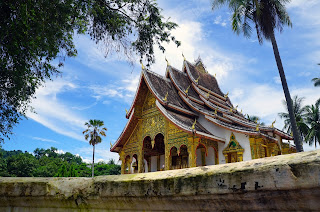Although my first impression of Laos
was not positive - petty extortion at the Veun Kham border post - the country
very quickly won me over with its friendly and welcoming people, its amazing
landscape and rich cultural legacy.
For a multimedia overview of Laos
please take a look at my first foray into travel videography with Laos: Lands of Peaks and Rivers.
For a country with such a long and illustrious history,
stretching the millennia between the megalith carvers of the Plain of Jars to
the legendary kings of Lane Xang, Laos
today boasts just two world heritage sites: Wat Phou in the far south and the
town of Luang Prabang in the north.
While each is remarkable in its own way, only Luang Prabang features on South-East
Asia's top-tier tourist trail, which has resulted in masses of
visitors there while comparatively few make it to Wat Phou.
Luang Prabang
With daily flights from Bangkok,
Chiang Mai and Hanoi, Luang Prabang
is for many visitors an optional add-on to a holiday in Thailand
or Vietnam. This
in turn has fuelled tourism-related growth in the city and environs that verges
on the unsustainable: traditional residents and merchants priced out of their properties
in the old city; threats to the integrity of historical buildings and
landscapes on which the city's world heritage depends; and environmental and
infrastructure pressures as the city's hotel stock continues to grow unabated.
Highlighting the pace of change in Luang Prabang, the
authors of a recent study have observed that visitor numbers have grown 890
percent between 1997 and 2016 (from 62,348 to 617,239) and the number of
tourism-oriented businesses has grown 87 to 786 over the same period. In this
context it is no surprise that UNESCO's World Heritage Committee has issued a stern
warning to Laos regarding the impact of escalating development pressures on an
already vulnerable landscape, nor that Luang Prabang has become rife with the
tourist-targeting hustles and hassles that are practically non-existent
elsewhere in the country.
That being said, the Laotian authorities are clearly making
efforts to manage and control development within the old city and significant
investments are being made in the upkeep and restoration of key sites, notably
Wat Xieng Thong. Moreover, despite the crowds and kitsch-peddling souvenir
stores and night market, the old city's setting at a narrow strip of land
between the Mekong and Nam
Khan Rivers
is outstanding.
Equally impressive is Luang Prabang's urban landscape, which
features the Royal Palace, dating to 1904, dozens of ornately decorated
monasteries, traditional Asian shophouses as well as stately French-era
mansions, all watched over by the spirits thought to inhabit Phousi, a thickly
forested hill at the centre of the old city.
Some practical details (current as of July 2017): Arriving from
Vang Vieng by minivan at Luang Prabang's "tourist" bus station, it
cost us 60,000 LAK for a jumbo to take
us (four people) to our hotel near Wat Xieng Thong in the old city. While many
wats are free to visit (with donations welcomed) some charge an entry fee,
notably Wat Xieng Thong (20,000 LAK). Meanwhile, it costs 30,000 LAK to visit
the Royal Palace
Museum, where a dress code,
especially for women, is vigorously enforced, and 20,000 LAK to climb to That
Chomsi high above the old city. For those interested in learning more about
Luang Prabang's oral history, what must be the world's smallest theatre mear
Wat Xieng Thong offers a great two-man show every evening for 50,000. Finally,
those wishing to have their clothes washed would do well to avoid the small
laundry on the side street just south of Ock Pop Tok: I will spare you the
details but suffice it to say that it necessitated police involvement and was
undoubtedly my least pleasant experience in Laos.
Wat Phou
The contrast between Luang Prabang and Champasak, the
jumping off point for most visitors to Wat Phou, could not be greater. A sleepy
village strung along the west bank of the Mekong River, Champasak has a few
hotels and low-key restaurants, set among crumbling colonial-era mansions and a
beautiful backdrop of rice paddies and jungle-covered hills.
Wat Phou, or Sacred
Mountain, lies about ten kilometres
south-west of Champasak, and for my money is the most evocative ancient Khmer
site anywhere. Inscribed as a world heritage site in 2001, the temple complex
was built between the 6th and 12th centuries CE amid lush forest and under the
shadow of a 1,500 metre summit, which was capped for untold centuries with a
carved stone Shivalinga. And as testament to the site's religous significance
down through the ages, Wat Phou boasts a number of pre-Angkorian carvings,
notably the "crocodile stone" which some believe served as an altar
for ritual sacrifice for the area's early inhabitants.
On the day of my visit there were just a handful of
visitors, mostly Laotian along with a few tourists from neighouring countries.
Having been in Siem Reap just a few days previously, the different in scale -
whether in relation to the crush of tourists or the overbearing visitors centre
- was stark and very much welcome.
Some practical details (current as of July 2017): Staying at a
hotel north of Chamapasak, we paid 120,000 LAK for a roundtrip to Wat Phou by
tuk-tuk with a stop in town on the way back. Entry tickets cost 50,000 LAK. For
great food and drinks at a wonderful riverside setting, try Champasak with Love
near the centre of town; we liked it so much we ate and drank there almost half
a dozen over the course of three days.






No comments:
Post a Comment